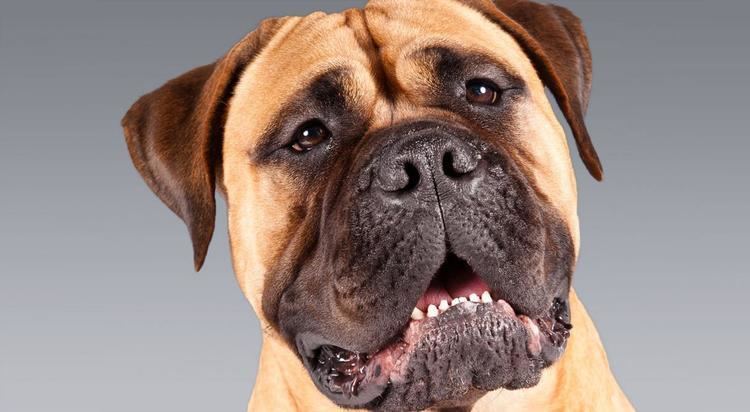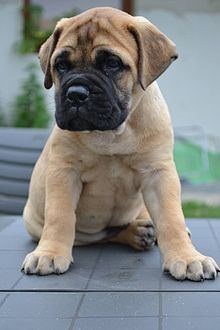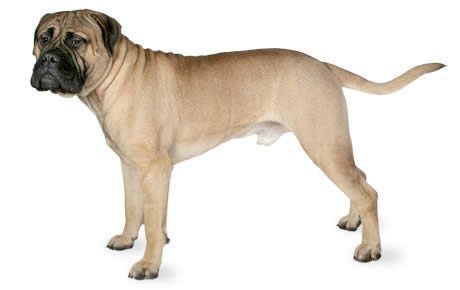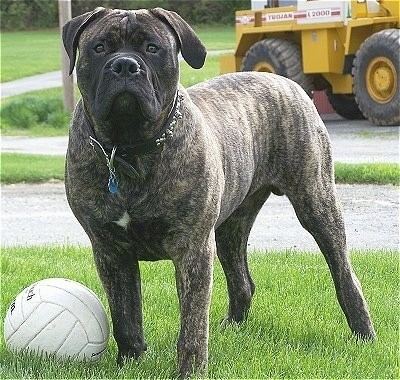AKC Working ANKC Group 6 (Utility) Life span 8 – 10 years Colors Red, Fawn, Brindle | Working standard Group 6 (Utility) standard | |
 | ||
Coat Short and weather resistant Temperament Reliable, Devoted, Reserved, Protective, Alert, Docile, Loyal, Calm, Powerful, Courageous, Loving Height Male: 64–68 cm, Female: 61–66 cm Weight Male: 50–59 kg, Female: 45–54 kg Similar English Mastiff, Dogue de Bordeaux, Rottweiler, Great Dane, St Bernard | ||
All about living with the bullmastiff
The Bullmastiff is a large-sized breed of domestic dog, with a solid build and a short muzzle. The Bullmastiff shares the characteristics of molosser dogs, and was originally developed by 19th-century gamekeepers to guard estates. The breed's bloodlines are drawn from the English Mastiff and the extinct Old English Bulldog. It was recognized as a purebred dog by the English Kennel Club in 1924. They are quiet dogs and very rarely bark.
Contents
- All about living with the bullmastiff
- Bullmastiff a dog lover s introduction
- Size
- Color
- History
- Trainability
- Health
- Famous Bullmastiffs
- References

Bullmastiff a dog lover s introduction
Size

Males should stand 25–27 inches (64–69 cm) tall (American Kennel Club (AKC) standard) at the withers and weigh110–130 pounds (50–59 kg). Females should be 24–26 inches (61–66 cm) at the withers, and 100–120 pounds (45–54 kg). Exceeding these dimensions is discouraged by breeders.
Color

A Bullmastiff's coat may appear in fawn, red, or brindle. These are the only acceptable colors in the AKC standard. The fawn can range from a very light brown to a reddish brown. Red can range from a light red-fawn to a dark, rich red. Brindles are a striped overlay of the fawn or red. A Bullmastiff should have no white markings, except for on the chest where a little white is allowed.
History

Bullmastiffs are a large working breed originating in Britain in the mid 1800s as estate guardians to ward off poachers. They were bred by gamekeepers for strength, size and speed using a cross of the tough, heavy and aggressive Bulldog of the 19th century with the large, strong, less aggressive Mastiff. As a result, the Bullmastiff is known as the Gamekeeper's Night Dog. The preferred color, by gamekeepers, was brindle, as this color works as a more effective camouflage, especially at night.
The Bullmastiff breed was deemed pure by the English Kennel Club in 1924, with a genetic background of approximately 60% Mastiff and 40% Bulldog. In 1934, the AKC recognized the Bullmastiff. The first standard for the breed was approved in 1935. The standard has undergone several revisions since then; the most current version is available on the AKC website.
Trainability
Bullmastiffs are strong, powerful, but sensitive dogs. For a Bullmastiff to become a well-behaved family member, consistency is needed. Training and socialization is of high importance, as the breed can be independent. Dogs of this breed are natural guardians of their home and owners. No special guard training is needed for a Bullmastiff to react appropriately if its family is endangered. During training, a Bullmastiff requires a special approach, because these dogs do not like to repeat the same actions again and again. Activities Bullmastiffs enjoy include obedience, agility, tracking, and carting.
Health
A UK survey puts the median lifespan of the Bullmastiff at 7 to 8 years old. A Bullmastiff does not stop growing until it is about three and a half years of age.
Health concerns within the breed include hip and Elbow dysplasia, Progressive retinal atrophy, bloat, and cancer, with a relatively high incidence of Lymphoma and mast cell tumours. Bullmastiffs are prone to certain hereditary diseases, including:
Cosmetic genetic problems include longhairs and "Dudleys". Both are recessives and not common. The Dudley, named after a notable Bulldog breeder of the 19th century, the Earl of Dudley, is a lack of pigment in the mask. It can be liver colored or simply not present.
